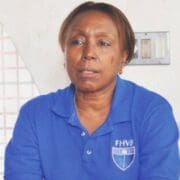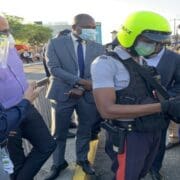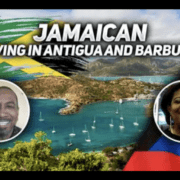Black Immigrant Daily News
JAMAICANS.COM
In our “Jamaicans to the World” show, Jamaicans.com founder Xavier Murphy speaks with Marjorie Parchment. She is a Jamaican living in Antigua and Barbuda.
Xavier: What is it like being a Jamaican in Antigua and Barbuda? Hi, I’m Xavier Murphy, the founder of Jamaicans.com, and today in Jamaicans to the World we talked to Marjorie Parchment; a Jamaican living in Antigua and Barbuda. Welcome Marjorie. How are you?
Majorie: Xavier, I’m fine. Thank you so much for inviting me to be a part of your program. I listened to some of the examples you sent to me and they’re absolutely awesome. We have Jamaicans living everywhere and I’m here in Antigua and Barbuda. I have lived here for 32 years and five months. I actually came here to work on a 2 year contract and I’m here ever since. As they say, the rest is history.
Xavier: Tell us which part of Jamaica are you from?
Majorie: I am from St. Elizabeth. Very proud to have been raised in the rural parts of Jamaica. I am from a small village on the south coast of St. Elizabeth called Fort Charles. It’s eight miles south of Black River and we are about two miles from Treasure Beach. If you’re actually traveling to Treasure Beach on the south coast, you will pass our family home and all our family who still lives there. Yes, I’m a rural girl.
Xavier: Which of the two islands are you in? Are you in Antigua or Barbuda?
Majorie: I am in Antigua, which is the larger of the two islands. Barbuda is 62 square miles and has only about, let’s say a thousand inhabitants. A 1000 persons live on Barbuda and about 95 or 96,000 people living on Antigua, as I said the larger of the two islands. And, I’ve been here all of my 32 years in Antigua and Barbuda. Yes.
Xavier: Would people refer to, and I know I may not be politically correct when I say this. But do people refer to Barbuda because there are less people there, kind of as the country,
Majorie: Do they refer to Barbuda as a country? No, they only refer to Antigua and the Barbuda.
Xavier: No, Here’s the question, yuh know like (you know, as) you said, you’re a country girl.
Majorie: Yes.
Xavier: And St. Elizabeth is the country. Would they refer to Barbuda as the country? Because again, there are less people living there.
Majorie: No, not really. I mean, there are other places in Antigua that they would refer to as being in the country area. If you come from the south,if you’re from Old Road, which is a village, or if you come from Bolands, that would definitely qualify you as being a country girl or boy. Antigua is relatively smaller. As I said before, Antigua is 108 square miles and Barbuda is 62 square miles, more than half of the size of Antigua but has a very, very small population. And of course you would recall that Barbuda was heavily damaged in 2017 by hurricane Irma. And so most of the person’s left, the entire island was evacuated because we had another storm coming. And so some persons have not returned, but prior to that, they had about 1500 persons living on Barbuda.
Xavier: I see. And is it because people have left and because the population, if you’re talking about environment, if you’re talking about really untouched area, Is that what Barbuda is like?
Majorie: Barbuda is as close as you can get to a naturally beautiful part of Antigua and Barbuda. It is scenically very, very pretty, and the beaches are second to none. I would say that Barbuda while underdeveloped is a beautiful island. And, I think in due time, Barbuda will be developed at the pace that Barbudans want to develop at. And also, they will have development on their own terms. And I think there’s everything good about that. They truly believe in protecting and preserving the environment for future generations. And they’re usually very uncompromising when it comes to that. Investment, yes, it’s always welcomed, but they wanted to be on terms that will continue to preserve and protect the environment.
Xavier: I see. I know I spent a little time there on Barbuda and I just figured it’s interesting that it’s a twin island and sometimes we hear a lot more about Antigua than we hear about Barbuda. And so I just wanted a little insight. Provide a little insight to folks on Barbuda.
Majorie: Barbuda is a little north of Antigua, Antigua is further South than Barbuda on the island chains. Barbuda is a little south of us. And so, of course when Irma shifted slightly north, what happened is that it covered Barbuda and caused widespread damage. Yeah, they were unfortunate that way.
Xavier: Another question before I again, focus a little bit on Barbuda. How long does it take to get there? I understand there’s a ferry that takes people back and forth. How long does it typically take?
Majorie: About two and a half hours to get to Barbuda? And it could be less if you’re in a faster boat, but typically the tourists boats would take about two and a half hours to get there.
Xavier: Okay. And, there are no airports?
Majorie: There is a small air strip in the Capital, which is called Codrington. And of course the main airport V. C. Bird International Airport is here in Antigua. It’s an international airport. You can go into Barbuda now on a sea plane or you can go into Codrington on a regular twin-engine, small plane.
Xavier: Okay.
Majorie: Not my cup of tea (not what one likes or is interested in) coming from Jamaica as you would imagine.
Xavier: Yeah. I’m going to take you back down memory lane, because you’ve been there 30 add years (over 30 years). What was your biggest adjustmentcoming from Jamaica to Antigua and Barbuda? When you got there, what would you say was your biggest adjustment?
Majorie: Well physically, when I came here 32 years ago, you could still go to town and leave your door unlocked. I could still leave my children at home because I know they’d be safe. And I would say to the older one, at the time I had two children, “look after your brother, I’ll be back in aminute.” You’re not likely to do that if you’re living in a city like Kingston, where I lived before I came here. I welcomed that change because it was very similar to how I was raised. When I was a child in St. Elizabeth, we only locked our doors once a year. And that’s when we were going to visit family on New Year’s or Christmas. And when I came here, I could do the same thing. There were no burglar bars and the place was relatively safe, 0-1 murders per year. Of course with progress, things have changed. And while I still do not have burglar bars at my own house, with very large windows, I have a security system. And I guess that is good enough for now to frighten people off, but yeah, still a relatively safe country.
Xavier: Okay. I see, that’s good to know. Very good to know.
Majorie: It’s like now, I’m here in my office, and while we have impact windows we have no burglar bars. We have security system and of course we have guards, but we’re not barricaded in as you know. And I’ll tell you this Xavier, When I returned home after spending years in Antigua I used to feel a little unsafe and I used to say it to my mother, bless her soul; we need to leave one door without a burglar bar on it because if something happens like a fire, it will be difficult for her to get out. So yes, it took some adjustments, no burglar bar.
Xavier: I see. Getting there and working there, and again, this has probably changed since you got there, but you may know people who have tried to come there and work there and so on. Is it a difficult process?
Majorie: Not necessarily because they do recognize the CARICOM certificates. If you have been to the University of West Indies you can live here for up to 6 months. You can work here on your university degree so, that’s not an issue. I actually came here having not to gone into the University of the West Indies but having a professional qualification. I was given a work permit to work here so, my employer applied for the work Permit. And it’s not difficult to have, if you have the skills that they are looking for. Antigua also needs workers, generally at all levels. At the manual level, we have a lot of Jamaicans and other Caribbean nationals who work as security guards, for example, and work in the hotel industry at various levels. And we have a Sandals here.
There are several Jamaicans in the professional category, but we also have Jamaicans from all walks of life, all nationalities, and all areas of Jamaica. And of course, what you will find is that a lot of the Jamaicans who are here are from St. Thomas. And I can’t understand why so many persons from St. Thomas are here. But it probably started with the one, then of course escalated to so many. But we have Jamaicans from all over, very few from St. Elizabeth, but from St. Thomas, yes and St. Catherine.
Xavier: You representing St. Elizabeth there?
Majorie: I am proudly representing St. Elizabeth, Yes.
Xavier: How do the people of Antigua and Barbuda view Jamaicans?
Majorie: Oh, with awe and some not so. One of the things that I found welcoming about living here. When I arrived, persons could not tell that I was not an Antiguan because of the way we speak. Antiguans, Barbudans and Jamaicans are very similar and there’s a historical link to that. Persons will tell you that when they had slaves back in the day, those that wouldn’t behave themselves and were a little boisterous, they would send them to Jamaica. And so there was always a trade-off. From the way we speak, I always talked to persons and I would ask some if they were from Jamaica and after I did that for a few times, and they’d say “No, I’m not from Jamaica” I realized, “okay, this is it.” And so there were persons then who thought I looked like a family and they would ask, “Oh, when did you come back?” For example, I’m like, “Come back from where?” But it just tells you that we probably have a copy everywhere. I’m sure if you walk down the streets of Antigua, somebody would say “Oh, you’re Mr. XYZ son” or something like that. So it was unique. And I felt at home when I arrived here.
Xavier: Good, good. So in terms of our Jamaican language or Jamaican Patois, it blends right in I guess, very similar.
Majorie: Yes. Very similar. The language, the dialect is very similar. Just some little nuances, but outside of that, very similar dialects. Yeah.
Xavier: Aright mi gwine put yuh pan di spot. Gimmi one addi nuances. (Alright I’m going to put you on the spot. Give me one of the nuances.)
Majorie: For example, we would say unuh (you all) in Jamaica and Antiguans would say, y’all (you all). So, that’s one of the slight differences, but we have a lot of things in common, more than any other Caribbean island I’d say.
Xavier: Have you visited any of the other islands? It sounds like yuh ave (you have) visited a few a di (the) other islands.
Majorie: I have pretty much visited all except two, Grenada and St. Vincent I have not visited. But I’ve been to all the other islands in the north Eastern Caribbean.
Xavier: So let’s get nosy for the audience. If you’re visiting all the islands, what do you do?
Majorie: When I’m visiting the islands?
Xavier: No, occupation wise. Is it a job that takes you to all these islands?
Majorie: Pretty much, most of the time it starts out with going for an appointment or something like that. I’m an insurance agent, and in addition to being an insurance agent, I also work along with the principals that I represent. And I do some training for them as well on the side. So many years I traveled to several islands to train existing staff. Yes. But my current job is I work as the manager of this insurance agency here in Antigua called Brysons.
Xavier: Okay, Good. I guess in the future Grenada is on the list.
Majorie: Yes, Grenada and St. Vincent. I’ve been to the airport of St. Vincent but never visited really. And I’m looking forward to visiting those islands. Yeah.
Xavier: I know a lot of the islands we have similar fruits but we typically call them different food and fruits. We call them by different names, and did you encounter any of that in Antigua and Barbuda?
Majorie: Yes. There are some fruits that I have not seen here from Jamaica. I was talking to my friend this morning about star apple. He believes that there are star apple trees all over a certain area called Bolands for example, but I have never seen them. I’ve see naseberry trees, which Antiguans called Sapodilla, but we call it naseberry. Most of the fruits are here. Mangoes of course, uniquely, nobody can have a different name for mango except mango. And of course our sweetsop in Jamaica is a sugar apple here. Yes, different names but same thing.
Xavier: Let me ask you this because it’s almost where we’re getting into the mango season time shortly. And I know there are certain mangoes that we tend to cherish and I have visited a few of the Eastern Caribbean islands and I remember one island I went to where Bombay was just like, “oh yeah, bombay all bout di place” (Oh yes, Bombay mangoes are all over) and we would cherish the bombays. And so have you found any of that in terms of the mango? Because, you know, we have our levels of elite mangoes and levels of other mangoes. So have you encountered any of that with the mangoes there?
Majorie: Well, the most favorite mango in Antigua is the kidney mango, which is our common mango. Antiguans like to call every mango that’s not a kidney mango, a grafted mango. Everything else falls into that category. They’re not so inclined to have different names, everything else is grafted. But kidney mangoes are just plain and utter kidney common-kidney.
Xavier: Since they’re ignoring all addi (of the) other mangoes, I guess if you see East Indian, a Julie or a Bombay you get in the cream addi (of the) crop, it’s probably less, the pricing is probably less than the kidney.
Majorie: No, Not, really. It’s usually more, but we have Julie here and that’s grafted. Most people wouldn’t say it’s a Julie mango, they just say Julie. And we don’t really have East Indian mangoes at all. East Indian is priority in Jamaica. We have other large mangoes, but as I say, everything else is other than kidney is just grafted. So you don’t really hear the reference to a name, so to speak. Like we in Jamaica, we would pride and love our East Indian Mangoes. You don’t really have East Indian here, but everything else is just, enuh (you know).
Xavier: Okay. And I know most people are going to assume, and I won’t do that, that you’re getting all your Jamaican food there. The question is, are you, or, is there anything that you find that you’re missing?
Majorie: Well, I think because we’re not traditionally using the same sort of seasoning, we don’t have our scallion and the real purple scallion to throw in the flavor, and the food is not as fresh because a lot of our food and vegetables are imported. The food doesn’t really taste the same, but I’ll tell you, I was so homesick for some Jamaican oxtail on Friday that I went down to a likkle (little) cook shop, just at the back of my office here and got myself a good oxtail. I mean, it was a tossup between the oxtail and the curry goat, but I chose the oxtail because I hadn’t had oxtail for a while. I guess it was homesick. I haven’t been to Jamaica since March of last year. I am really homesick.
Xavier: Oh boy.
Majorie: When I come back I have to do the two weeks of quarantine and I can’t afford that. I have not traveled since March.
Xavier: I see. I see. In terms of Antigua and Barbuda, the food, is there something that’s uniquely done there that you like and you would say, “I would recommend you try this”
Majorie: Well, we have a similar dish in Jamaica, pepper pot, it’s my favorite Antiguan dish. I can’t cook it. And the persons who have cooked it for me the best, have both died. It was a friend of mine and our cleaning lady back then, both have passed on. But essentially it’s similar to our pepper pot in Jamaica but it’s a lot thicker? So while you have it with a spoon, it’s not really a soup, whereas our pepper-pot in Jamaica is a soup. But it’s just a quicker version and it has more ground provisions in it and so on. It usually has everything, pig tail and chicken. You can choose how you want it. If yuh (you) don’t eat pork, yuh (you) can have the one without pork but typically I want the one with everything. What’s bad for you, it tastes the best. And of course there are places Xavier that sell jerk chicken and jerk pork. My favorite jerk pork place was burned down, so I can’t go there anymore and the lady is not doing jerk anymore. But essentially you can still get some jerk pork and some jerk chicken.
Xavier: Good, good. In terms of the place itself and attraction. Yes there’s the beach and other things, probably zip-line and other things you can do. But what for you would you say is unique to Antigua and Barbuda? Something that you would say, “if you come here, try and do this” What would that thing be? And it may be only once a year, it happens. It may be an event, but would that thing be?
Majorie: It’s the Shirley heights climb on a Sunday evening. It’s usually starts about 4:00 p.m., but now with COVID you can’t. But when we all get vaccinated and we are healthy and COVID is a thing of the past and you visit Antigua, you must do this Shirley Heights climb. You get up there from about 4:00 PM, there’s food, live music and it’s just a very beautiful scenery. It’s set in an old 18th century barracks dating from 1700. And you overlook what is the national parks of Antigua. And that national park also has 18th century buildings, the relics of. And some of those buildings have been modernized and refurbished. You can stay in an 18th century hotel with all the modern amenities in the national parks, which is an area called Nelson’s dockyard. It’s a beautiful area of Antigua, very, very beautiful. You would love it. Of course, we also have some mega yachts coming in as well, but it’s just a very beautiful part of Antigua that has a very rich history.I was very impressed by the fact that, in the 18th century when Lord Nelson and his soldiers lived in that general area, that they would have a way of communicating with their other soldiers in the city of Antigua. And also, that there was once an erosion over time. There was actually a way to prevent the enemy ships from getting into the harbor, which was a protected area. That area is called Nelson’s dockyard and it has restaurants, hotels, and other amenities there. And of course, Shirley Heights is a height from where Lord Shirley looked out and saw the whether the ships were coming in or not, and what to do. And of course they are old cannons up there. It’s a rich, it’s a nice place. And the scenery is very, very beautiful, breathtaking. That is what I would recommend.
Xavier: Okay. You mentioned live music and I didn’t touch on the music. Calypso, Soca is that dominant?
Majorie: Calypso and reggae.
Xavier: And reggae? You’re hearing your reggae there?
Majorie: Yes, of course. They would do all the Jamaican reggae artists, they’ll try their best. Of course, I will say that when it comes to culture and food, Jamaica takes the high road really, and we are ahead of most persons. But they would have good renditions of all the Jamaican artists.
Xavier: Good. Good. My last question. When you land in Jamaica, What is that first thing you’ll be doing when you get off the plane? Is it food? What is that first thing you’re going for wen yuh lan? (When you arrive)
Majorie: When I land in Jamaica, one of the things I enjoy doing the most is driving from Kingston, from Norman Manley or from Montego Bay, driving to see my family. And usually, Jamaicans and especially the Parchments are very good at throwing a party for everything. I would stop at my niece or stop at my sister until I get to my mother’s house where we’ll have some big food, you know, somebody put on a kerosene pan or a big pot with some curry goat and manish water. But I like to take in the scenery heading home. And, of course, the mountains, the valleys and of course stopping by the side of the road and buying jerk and boiled corn, all the things heading down the hill. For me, I love to do that especially with my sister, one of them you know.
Xavier: Yes.
Majorie: That’s it. I usually don’t want to do much than seeing the family, enjoying the views and eating the jerk pork, boiled corn and other things.
Xavier: Yuh having my mouth wata (you are making my mouth water)
Marjorie: Yes, if you get to border you may want to also have some fried fish and bammy too but usually you are full.
Xavier: No yuh (you) pack everything and say, listen, “I moved from three meals for the day to five meals when I come to Jamaica” I know I said it was the last question, but what would be the one piece of advice you would give to any persons that are thinking of moving to Antigua and Barbuda to live?
Majorie: Right, I think one thing you must recognize is that even though we have a dollar that is pegged to the US dollar at 270, that the cost of living is also high because of that. You can enjoy a good lifestyle here, but it is expensive. So you can’t always say that because you’re getting more money that you would be able to live in a certain lifestyle. You always have to look at how much it costs to live before you make that decision to move to another country or to Antigua in particular as the cost of living can be high. The cost of rent, for example, most persons would need to rent. The cost of sending your children to private school. You want to factor all of that in before you make that decision to move to Antigua.
Xavier: Okay. Very good advice. Marjorie thank you.
Majorie: Food is expensive as well Xavier, because as I said before you import everything. At least most things you import.Xavier: Well, Majorie, I appreciate you taking some time out of your day to tell our viewers, tell us all about Antigua and Barbuda. I have one last thing I do, and this may put you a little bit on the spot, but yuh (you) know in Jamaica wi seh (we say) “likkle more” (little more) the older people “Ketch yuh pon de strangs” (catch you in the strong/later) informal way of saying we will see you later or see you at another time. How do they say that in Antigua and Barbuda? Is it just regular, formally bye-bye, goodbye or do they have a term they use?
Majorie: To be honest, it hasn’t come to mind right now, but it’s usually “see you later”, or I’m sure that there’s an equivalent, but it can’t come to mind right now
Xavier: Email mi, email mi or message mi den. (Send me an email or a message).
Majorie: Sorry
Xavier: I said, if it comes to mind just for my curiosity and I may tell my viewers in the comments. Email me, because I know I put you on the spot. It’s a last question I typically ask and I put people on the spot. But you gave us some…Majorie: You know in terms of my wicket falling, because I can’t remember what it is uniquely that Antiguans say, when they’re saying goodbye.
Xavier: Well, you just said something there because I know cricket is big there and the wicket falling. Maybe that’s a term that is used a lot there.
Majorie: There’s always references to cricket. Cricket falls into our daily dialect a lot. And usually it’s cussing (cursing) in West Indies cricket when they don’t perform. And harking back to those good old days of Vivian Richards, Curtly Ambrose and of course Richey Richardson. Yes, cricket is a factor of our lives here.
Xavier: Well, again, Majorie, thank you again for spending some time with us, giving us some great information and we will always be in touch. We have mutual friends. Her sister is a very good friend of mine, so we’ll always be in touch and I will see you when I get there the next time around. I will make sure I visit. You have a good one. And thank you.
Majorie: Thanks for inviting me. It’s been a pleasure. And I just want to wish all Jamaicans who are going to see this program, I want to wish them well. Stay safe from COVID, let’s get vaccinated and let’s continue to practice our protocols. You know what they are Xavier but in this pandemic we have to preserve our livelihood.
Xavier: Exactly. Marjorie tek care (take care).
Photos – Deposit Photos
CLICK HERE TO JOIN OUR WHATSAPP GROUP
NewsAmericasNow.com











